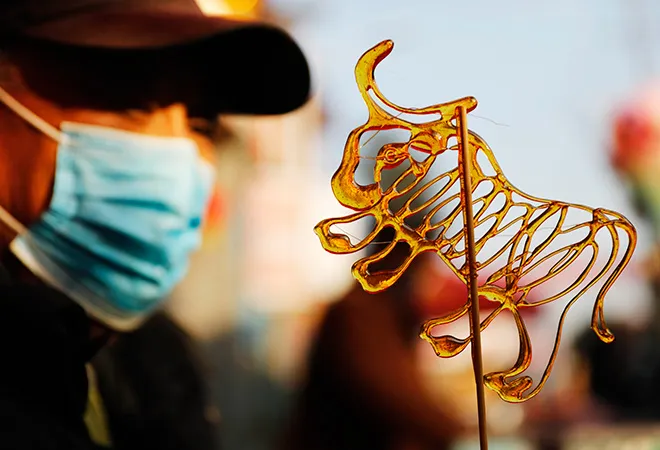-
CENTRES
Progammes & Centres
Location
It seems that China is already gearing for 2021 on two accounts — dual circulation and domestic innovation.
 This article is part of the series — What to Expect from International Relations in 2021.
This article is part of the series — What to Expect from International Relations in 2021.
The Chinese are probably looking forward to 2021. The Chinese New Year, which commences on February 2021, will mark the Year of the Ox (niú 牛), according to their 12-year zodiac. Ancient China was an agrarian society where the ox was a prized possession and signified prosperity through hard work and sincerity. Coming after 2020, the ‘Year of the Rat,’ that is said to unleash natural calamities and disaster, hopes are being pinned upon 2021.
The last two ‘ox years’ that China witnessed have been epochal, where its tenacity seemed to have been rewarded. In 1997, Hong Kong reverted to Chinese control, ending more than 150 years of British colonial rule. For China, it meant the reversal of the “Century of Humiliation,” following the Opium War, and restoration of national sovereignty.
In 2009, after merely three decades of opening up to the world, China overtook a major European nation like Germany to become the third-largest economy. It was viewed as China succeeding in the backdrop of the sharp currents of the 2008 global financial crisis.
It seems that China is already gearing for 2021 on two accounts — dual circulation and domestic innovation. In the aftermath of the pushback against China, due to the pandemic and its tensions with the US, President Xi Jinping announced in November a major course correction for the economy. Since the reforms of 1978, China pursued a strategy titled ‘international circulation,’ in which it harnessed its vast reservoir of educated youth into export-oriented industries. This got China the tag of the ‘factory of the world,’ ensconcing the nation firmly into global supply chains. However, today, the ground reality has changed: In 2006, one-third of China’s GDP consisted of exports, the corresponding figure for 2019 was barely 18%. China is now shifting gears: It would be still be open to international trade, but its domestic market would be the main driver of the economy. This policy shift titled ‘dual circulation’ would be at the centre of the five-year plan for 2021-25, revealed the Chinese Communist Party (CCP). The 14th five-year plan is scheduled to be approved at the annual sitting of China’s parliament in March 2021.
The second priority is enhancing the innovation ecosystem to cut Chinese reliance on the West. This has led to investment in high-tech sectors like semiconductor chips. In August, tax sops and capital support were announced for semiconductor firms. Currently, China makes barely one-third of the chips, but plans to boost production to ensure that in the next five years nearly 70 percent of the production is in-house.
Apart from changing gears in domestic trade and policy, the year of the ox also coincides with the centenary of the CCP. The party has made it till here with a great deal of doggedness and resolve. However, vaunting its achievements can be a tricky business.
Memories of Mao’s Cultural Revolution, which aimed at weeding out traditional and capitalist mindsets of the Chinese may not be fresh, but they still rankle many. Despite his ‘Princeling’ background, Xi himself faced the ignominy of being “sent-down” to the countryside along with 17 million other youths as a result of that upheaval in the late ’60s. The events that unravelled on 4 June 1989, at Tiananmen Square remain controversial till this day, and raking up the same is seen by the CCP as questioning its legitimacy. The CCP will have to sidestep these minefields with 100 movies, operas, and dramas showcasing its “positive contributions” like raising living standards.
From this point on, Xi will also be heavily invested in the future of China as it will be closely tied to his. Having indicated that he will still be firmly in the saddle after his 2nd term ends in 2022, Xi may start laying the groundwork for building China as a prosperous, strong and modern socialist nation by 2049. This work-in-progress may be his raison d'être for continuing in power.
The views expressed above belong to the author(s). ORF research and analyses now available on Telegram! Click here to access our curated content — blogs, longforms and interviews.

Kalpit A Mankikar is a Fellow with Strategic Studies programme and is based out of ORFs Delhi centre. His research focusses on China specifically looking ...
Read More +